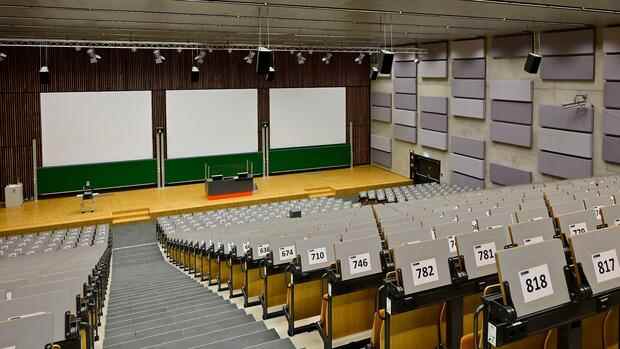In absolute numbers, the group of first-year students from Germany has even fallen from the all-time high of 450,000 ten years ago to around 400,000 due to demographic factors.
(Photo: imago images/Ralph Lueger)
Berlin According to the National Education Report 2022, the trend towards higher education “has come to a standstill for the time being”. The number of first-year students in Germany has stabilized at 45 percent. This is roughly in line with the OECD (Organization for Economic Co-operation and Development) average.
Axel Plünnecke, education expert at the employer-related Institute of German Business (IW), says that the academization of the past two decades was necessary. This “was also a reaction to the high shortage of academics in the early 2000s,” says the education expert. In 2005 not even a third of a school year started a degree.
The shortage has now been distributed more evenly, says Plünnecke: “There are now bottlenecks in some academic professions such as MINT – i.e. in the fields of mathematics, IT, natural sciences and technology – and medicine, as well as in numerous training occupations.”
The Federal Education Minister also wants nothing to do with competition between skilled workers here and academics there: “In Germany, we urgently need more clever minds and hard-working hands who can tackle the challenges of our time with competence and creativity,” says Bettina Stark-Watzinger (FDP). .
Top jobs of the day
Find the best jobs now and
be notified by email.
The Minister of Education adds: “The educational path is a personal decision. But we already know that there will be a large shortage of skilled workers in almost all areas.” That is bad for innovation and growth. Stark-Watzinger therefore wants to further promote the equality of professional and academic education and promote permeability and interlocking between the two areas.
Warning against “neglecting vocational training”
Just a few years ago, there was a debate about the rush to universities. Beginning in 2005, the beginner quota increased from 31 to almost 50 percent. Above all, the OECD had repeatedly criticized the low level of academization in Germany. In addition, there were far too few training places for the “apprentice glut” at the time.
In 2020, the number of people interested in vocational training fell below 900,000 for the first time – in 2005 it was 1.15 million.
(Photo: imago images/Future Image)
The critics, especially from the skilled trades and small and medium-sized businesses, rallied behind the battle cry of the philosophy professor at the Ludwig-Maximilians-University Munich, Julian Nida-Rümelin, about the “academisation mania”, which at the same time warned of the “neglect of professional training”. warned.
Kai Maaz, lead author of the education report, says that since the 2012 peak, however, “apparently a saturation point” has been reached. No further increase is to be expected for the next few years. In absolute numbers, the group of first-year students from Germany has even fallen from the all-time high of 450,000 ten years ago to around 400,000 due to demographic factors.
There are still “no signs of “over-academicization,” says Maaz, who heads the Leibniz Institute for Research and Information in Education (DIPF). Academics are still paid significantly better and are less likely to be unemployed than non-academics.
According to the report, only ten percent of master’s graduates and 20 percent of bachelor’s graduates between the ages of 25 and 35 work at a qualification level that does not correspond to their academic training. However, there were similar quotas earlier in the days of the diploma, says IW expert Plünnecke.
>>Read more: New low for applications for apprenticeships – training gap bigger than ever
In particular, graduates of courses remote from the labor market need longer to find a job with the desired content and level. In order to lower the rate, more career and study orientation is needed – for example to point out the good opportunities in the shortage subjects in the STEM area.
Only four out of five high school graduates are studying
The rush to get the Abitur has also calmed down: Today, about every second student does the Abitur – but switching to a university is no longer a matter of course. In the end, only four-fifths decide to go to university. In 2012 it was 90 percent. However, the halted trend towards academization has not led to a relaxation of dual training – the shortage is simply too great.
In 2020, the number of people interested in vocational training fell below 900,000 for the first time – in 2005 it was 1.15 million. This includes trainees, beginners in school training and those who initially end up in the transitional system. The group of new trainees alone has fallen by a quarter since 2007. According to an IW study, almost 40 percent of all apprenticeship positions remained vacant. Instead of studying, companies are now competing with the boom in health and education, which is attracting more and more young people.
The bottom line, however, is that “a change in the proportion of academics towards more or fewer academics at the expense of or in favor of vocational training would not help,” says Plünnecke, “because both are additionally needed due to demographics, digitization and decarbonization”.
It is therefore crucial “to attract more immigrants – for example through a course of study – to Germany”. The number of international students has tripled since the turn of the millennium.
After a corona-related slump, around 330,000 foreigners are currently registered again. But only a quarter then switch to the German job market. In addition, Germany urgently needs to “reduce the educational poverty, which is likely to increase,” with targeted funding measures, warns Plünnecke.
More: Study – Pandemic causes school performance of fourth graders to plummet


